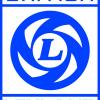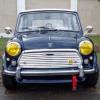Why yes, there has been some progress.

Moving is complete but it sure takes a lot out of you. A long time passed before I could get back into the swing of things and finish the design of the wiring harness. I wrapped that up a few weeks back and now it is time to construct it.

This is how I found her - sans harness (and just about everything else.
There are several ways to get the wiring harness built and installed in my Mini. My car came without a wiring harness so that option was off the table. The next route would be to simply purchase a reproduction original Mini harness, but there are far too many differences between my Mini as it originally rolled out of the factory versus how it is now. That would require so many changes that there would hardly be any of the repro harness left.
Considering I will be using the R1's ECU and any number of R1 sensors and actuators, the next choice would be to start with an original Yamaha R1 motorcycle wiring harness. I could strip out the circuits I don't need, add in a few that I do, lengthen a few wires here and there. That isn't a horrible idea and it is the norm for many BEC (Bike-Engined Cars) owners. My first harness design was just that - a modified R1 harness. I decided at some point that it too would require more changes than I cared for. Combined with the fact that the R1 harness I had was now 10+ years old and not in perfect condition made me decide once and for all to build the entire harness from scratch.
Even here I had a choice to make - build it myself or pay someone to build it for me. I received bids from a few local harness builders but they either required that they build the entire thing from scratch using their own stand-alone ECU (Motec, Pectel, etc.) or they wanted a small fortune. It would have been nice to just write a check and the work would have been done in a fraction of the time that I am taking but this option was ruled out. The upsides of doing the harness myselft would be me learning something about electrical circuits and I would be better prepared to diagnose and repair any electrical issues that might crop up in the future. I went back and re-read all the guides and manuals I had and got to work.
Now the next question to answer was what components would be used. In an earlier post I mentioned that I had already purchased some Tefzel wire. It came highly recommended as a tougher and slighter smaller diameter version of the usual wire found in cars. For connectors I was initially impressed with the Metri-pack and Weather Pack connectors. The rubber seals and variety of pin counts were good but the connectors are a bit large. Crimping the pins is easy to screw up and the recommended total number of connection/disconnections is lower than I would like. Definitely better than any number of cheap no-name connectors from the auto parts store, but I wanted something better.
That is when I read about Deutsch DT connectors. These are a bit smaller, still come in a variety of pin counts, and used silicon seals to keep the elements out. They are rated for more cycles and the pin/socket crimps onto the wires couldn't be simpler. It will also give me another reason to use the ridiculously expensive crimping tool that I purchased for building the circular connectors at the firewall.

Not cheap but a joy to use. This ratcheting crimper handles all three size pins/sockets used in the Deutsch connectors as well as the circular Amphenol connectors.

Strip the wire just enough to go into the socket...

...place them into the back of the crimp tool and squeeze.

The tool crimps the socket into the wire equally inwards on four sides.

The sockets are then slid through the silicon seal and into the body of the connector until locked in place.


Finally a cap is snapped into place that does several things. Its shape prevents the socket locking latches from releasing. This prevents the wires/sockets from ever sliding back out of the connector. The face of the cap also helps to ensure the sockets are correctly aligned towards their counterparts in the mating connector. Finally, the bevel shape helps guide the mating connector's pins into the sockets during assembly.

Another great piece of equipment I discovered was this Power Distribution Module. I can bring power directly from the positive side of the battery and it splits it into two outputs - a 50 Amp fused constant on and a 50 Amp fused switched. The latter is controlled by a built-in solenoid that I will trigger off of the ignition switch. Each of these two feeds will run to a different fuse/relay panel with always-on circuits (horn, emergency flashers, etc.) located in one and switched circuits (fuel pump, ignition, etc.) in the other.

Main power input on the lefthand screw, two 50Amp fuses under the cover, pass-thru for mounting bolt, the switched power trigger relay and then the two power outputs with the upper being switched power and the lower constant-on.
I purchased several lengths of Raychem DR-25 heat shrink, which isn't cheap but is very tough stuff. It is resistant to most chemicals found in engine bays, can deal with a lot of heat and is very abrasion resistant. I will be using it primarily in the engine bay.

Here is the stock R1's ignition coil sub-harness. Not bad but these wires and connectors have seen better days. I was going to use the existing connectors but cut the wires as close to the connectors as possible and splice in new wire. Not a very elegant solution. Thankfully I was able to find new replacement connectors.

Here is a new coil connector. It came with wire seals, new crimp pins, and a yellow locking tab with one spare.

Strip the new wire and assemble...

...crimp...

...and insert into the back of the connector.

Here I have installed four new coil connectors and a new coolant temp sensor connector.

And here is the finished product. Each section of wire is covered in protective heat shrink and transitioned together with Y-shaped heat-shrink boots. It should provide many miles of reliable service.

Here is the headlight + turn signal intermediate harness. The grey Deutsch connectors on the right plug into the back of the turn signal and headlight. The wiring is routed through the roof of the wheel well and then passes through the inner wing using the circular bayonet connector. From there is will route to the appropriate fuse/relay box.

The goal of the entire harness is correct functioning, ease of assembly/disassembly, reliability, and ease of troubleshooting. Not cheap in terms of parts cost or time in design and assembly but if the car never leaves me stranded I think it will all be worth it. There's still quite a bit left to wire up but progress is steady. More updates soon...
, I know someone who had tests done on the kad and Ms and the Ms hubs was best so i went for them..





















































